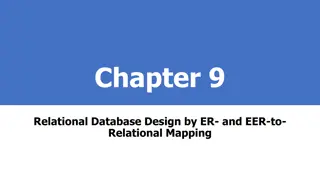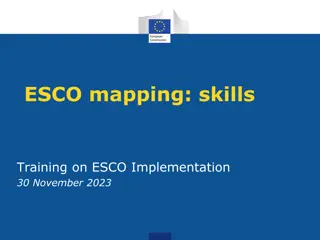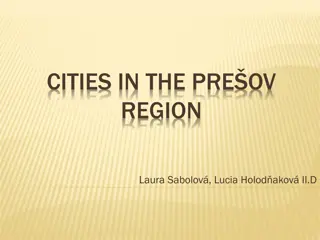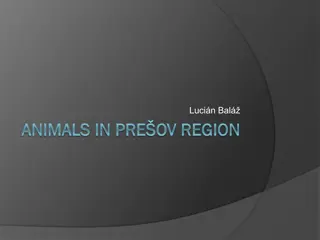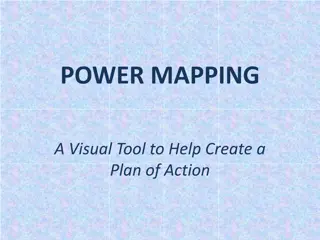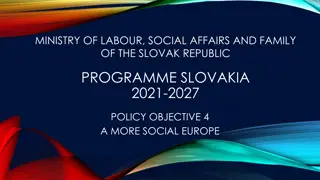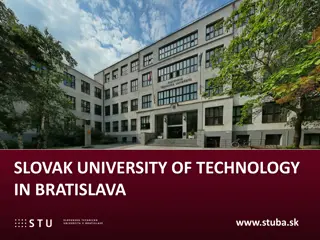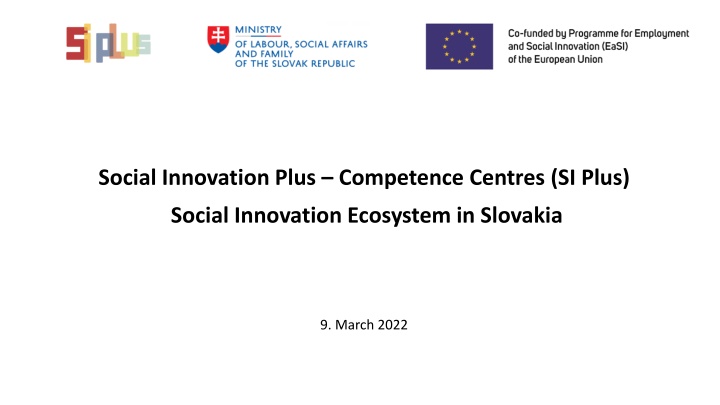
Insights into Social Innovation Ecosystem in Slovakia
The Social Innovation Plus Competence Centres (SI Plus) play a vital role in the social innovation ecosystem in Slovakia, as revealed through surveys, interviews, and analysis. The study highlights the diverse participation from NGOs, businesses, public administration, and academia, shedding light on the current norms, legal and political context, and public perception of social innovation within the country. Key findings include gaps in public awareness, urgent social issues, and areas with significant innovation potential, pointing towards the need for more focused efforts at different levels to promote social innovation.
Download Presentation

Please find below an Image/Link to download the presentation.
The content on the website is provided AS IS for your information and personal use only. It may not be sold, licensed, or shared on other websites without obtaining consent from the author. If you encounter any issues during the download, it is possible that the publisher has removed the file from their server.
You are allowed to download the files provided on this website for personal or commercial use, subject to the condition that they are used lawfully. All files are the property of their respective owners.
The content on the website is provided AS IS for your information and personal use only. It may not be sold, licensed, or shared on other websites without obtaining consent from the author.
E N D
Presentation Transcript
Social Innovation Plus Competence Centres (SI Plus) Social Innovation Ecosystem in Slovakia 9. March 2022
SOCIAL INNOVATION CONTEXT DRIVEN PHENOMENON Online survey - 113 respondents (approximately 11% of the contacts contacted) Out of which: NGOs: 30 (volunteer, foundation, NGOs) Business: 30 (bank, regular entity, individual, social enterprise) Public administration: 15 (regional government, local government, state government) Academia: 11 No answer for work affiliation: 27 Women: 59 Men: 51 No answer: 3 Local level - 17 Regional level - 31 National level - 23 Transnational level:17 No answer: 25 Qualitative semi-structured interviews 8 interviews
LEGAL AND POLITICAL CONTEXT LEGAL CONTEXT: Innovation - an underused term (more in the context of funding) Social innovation - only in the legislation on the provision of subsidies under the competence of the Office of the Deputy Prime Minister for Investments and Investments and Informatization (in context of Agenda 2030) Social economy and social enterprise - separate legislation POLITICAL CONTEXT: Political emphasis on the importance of social innovation is minimal, rather declaratory in nature Discussion is significantly driven by the external environment (e.g. ESIF)
PUBLIC PERCEPTION OF SOCIAL INNOVATION 81% of the adult population can not name an area where social innovation could be implemented (Focus/Pontis) Most urgent: (i) poverty and social exclusion, (ii) inclusion of persons with disabilities, and (iii) environment and sustainability Least urgent: (i) discrimination based on sexual orientation, (ii) the situation of refugees and (iii) international development cooperation Out of the 30 specific initiatives: 11 of poverty and social exclusion, out of the 7 on social service initiatives 6 focused on people with disabilities. 2 environmental initiatives and 1 health initiative Significant innovation potential can be identified in relation to access to and affordability of housing Digitalisation, the issue of interaction between online and offline, use of new technologies, AI or data platforms almost ignored Orientation to address the challenges of the immediate environment without the need to reach the national or supranational level
DIFFERENCES IN PERCEPTIONS BETWEEN GROUPS Situation of socially excluded communities (marginalised Roma communities) Sustainable mobility concepts Discrimination based on sexual orientation Situation of disadvantaged NEET young people Situation of people far from the labour market / long-term unemployed Situation of refugees Inclusion of persons with disabilities Gender equality / gender inequality Health care International development cooperation Human rights violations Environment and sustainability Demographic changes Living conditions of older people Climate crisis Poverty and social exclusion Unequal treatment in the education system Disadvantages on the labour market great need rather great need rather no need no need at all
DIFFERENCES IN PERCEPTIONS BETWEEN GROUPS Discrimination based on sexual orientation Situation of refugees Sustainable mobility concepts International development cooperation Gender equality Violations of human rights Demografick zmeny Situation of socially excluded communities (marginalised Roma communities) Living conditions of older people Unequal treatment in the education system NEET Situation of people far from the labour market/long-term unemployed Climate crisis Labour market disadvantages Healthcare Environment and sustainability Inclusion of people with disabilities Poverty and social exclusion -0.5 0 0.5 1 1.5 2 all male female
OPERATIONALISATION OF SOCIAL INNOVATION IN THE PUBLIC PERCEPTION The condition of cross-sectoral cooperation - 54.5% The need for empowerment and participation of disadvantaged groups - 58.5% Social innovation should be initiated by members of the target group - 17.5% Capacities of government and public institutions to implement initiatives that are compatible with the principles of social innovation - 34.5% Social innovation must be driven by a bottom-up approach - 47%. Social innovation must promote cross-sectoral collaboration between civil society and public administration actors Social innovation must strengthen the involvement of target groups and include an element of empowerment Social innovation can be implemented at local and/or regional level, not necessarily at national level Measures and projects initiated by a government or other public body (i.e. top-down measures) can also fulfil the principles of social innovation Social innovation must be driven by a bottom-up approach, i.e. change is initiated by those affected. 0% 10% 20% 30% 40% 50% 60% 70% 80% 90% 100% Strongly disagree Rather disagree Rather agree Strongly agree
SI must be driven by a bottom-up approach, i.e. change is initiated by those affected Measures and projects initiated by a government or other public body may also fulfil the principles of SI SI can be implemented at local and/or regional level, not necessarily at national level ALL ALL ALL 80 80 100 International NGOs International NGOs International NGOs 60 80 60 60 40 40 National Business National Business National Business 40 20 20 20 0 0 Public authorities Public authorities 0 Public authorities Regional Regional Regional Local Academia Local Academia Local Academia Male Female Male Female Male Female The initiative for the project must come from the target group. SI must promote cross-sectoral collaboration between civil society and public administration actors SI must strengthen the involvement of target groups and include an element of empowerment ALL ALL 50 80 International NGOs 40 ALL International NGOs 30 80 60 International NGOs 20 60 National Business 10 40 National Business 0 40 -10 National Business 20 -20 20 Public authorities 0 Regional Public authorities Regional 0 Public authorities Regional Local Academia Local Academia Local Academia Male Female Male Female Male Female
LIMITATIONS Level mutual trust in the society This (understood trust) in turn influences all other processes, the degree of tolerance for difference, the degree of tolerance for failure, the diversity of solutions. Trend to describe everything in a level of details which, in principle, precludes any modification or alteration This obsession with prescription defines the space in which we can move and does not allow us to actually cross some moments that we would like to cross. Absence of leadership on the part of the actors involved The key thing above all is not being afraid to be bold and confident and do things that, despite being necessary, have never been done. Low level of cross-sectoral cooperation, understanding and linkages It is not a sector-specific problem, the gaps are on the side of all sectors involved.
FINANCIAL SUPPORT - CHARACTERISTICS The absence of a personalised approach and any individualisation in selection processes Emphasis on the number of social innovations, not on their impact Unbalanced support for the different phases of SI Weak emphasis on SI identification and incubation
(NON)PRESENCE OF SUPPORT TOOLS FOR THE IMPLEMENTATION OF SI FINANCIAL SUPPORT: Explicit support of SI in two calls financed via ESIF 1. OP Research and Innovation main objective was to support social innovation in the environment of micro, small and medium-sized enterprises for the purpose of their commercialisation and application on the market call was canceled 2. OP Human Resources main objective was to support social innovations in poverty reduction not yet evaluated Important role of foreign donors (Velux Foundation) OTHER TYPES OF SUPPORT: Mentoring (mainly for young people Social Innovation Award, Social Innovation Reley)
PERCEPTION OF THE IMPORTANCE OF DIFFERENT TYPES OF SUPPORT On-line survey Interviews Networking Mentoring Funding - but for all phases of the SI and redistributed in a way that enables and encourages cross-sectoral collaboration and innovation per se Necessity to introduce new actors in ESIF redistribution Urgent need to support human capacity on the ground Concern about the reductionist interpretation of SI and the emphasis on start-ups Financial resources to implement social innovations Concrete support for the preparation of project applications Human resources needed to implement social innovations Cooperation between public authorities and civil society stakeholders Networking of actors at local level Exchange of experience and know-how with other countries Networking actors at supra-regional and national level General advice/guidance on definition and criteria (what is SI) 0% 10% 20% 30% 40% 50% 60% 70% 80% 90%100% Very important Rather important Rather unimportant Unimportant at all
SOCIAL INNOVATORS IN SLOVAKIA Political parties and organisations subordinate to political parties Religious organisations Research and scientific institutions Informal groups of citizens Public administration and local authorities Social partners (in particular trade unions and employers' Ordinary businesses Individuals Universities and colleges Professional associations and/or umbrella organisations Regional government and organisations managed by regional Non-governmental non-profit organisations Social enterprises Local government (municipalities and towns) and organisations 0.00% 20.00% 40.00% 60.00% 80.00%
INTRODUCTION OF 4 SPECIFIC SI PROJECTS Early intervention systemic change Municipality social enterprises - scaling up phase Affordable housing piloting phase Local food chance designing phase


